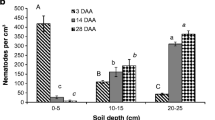Summary
The radial pressures generated by the earthworm Aporrectodea rosea were measured in a study of the conditions under which the worms were able to crack soil discs into which they were encouraged to tunnel. The tensile strength of replicate discs was determined by indirect tension tests and by expansion of rubber membranes in soil discs. Simple engineering theory was used to relate the stress required to fracture a disc with the applied internal stress. Mean values for the radial stress applied by the earthworms in tunnelling through the discs was 230 kPa. With some assumptions about the distribution of muscles across the worm diameter, it was estimated that the mean maximum force generated by all the longitudinal muscles in any segment was 3.2 N.
Similar content being viewed by others
References
Abdalla AM, Hettiaratchi DRP, Reece AR (1969) The mechanics of root growth in granular media. J Agric Eng Res 14:236–248
Barley KP (1959) Earthworms and soil fertility. IV. The influence of the earthworms on the physical properties of a red-brown earth. Aust J Agric Res 10:371–376
Dexter AR (1978) Tunnelling in soil by earthworms. Soil Biol Biochem 10:447–449
Dexter AR, Kroesbergen B (1985) Methodology for determination of tensile strength of soil aggregates. J Agric Eng Res 31:139–147
Horn R (1981) Eine Methode zur Ermittlung der Druckbelastung von Boden anhand von Drucksetzungsversuchen. Kulturtech Flurbereinig 22:20–26
Jamieson BGM (1981) The ultrastructure of the Oligochaeta. Academic Press, London
Lee KE (1985) Earthworms: Their ecology and relationships with soils and land use. Academic Press, London
McKenzie BM, Dexter AR (1988) Axial pressures generated by the earthworm Aporrectodea rosea. Biol Fertil Soil 5:323–327
Misra RK, Dexter AR, Alston AM (1986) Maximum axial and radial growth pressures of plant roots. Plant Soil 95:315–326
Newell GE (1950) The role of the coelomic fluid in the movements of earthworms. J Exp Biol 27:110–121
Popov EP (1952) Mechanics of materials. Prentice-Hall, Englewood Cliffs, NJ
Richards BG, Greacen EL (1986) Mechanical stresses on an expanding cylindrical root analogue in granular media. Aust J Soil Res 24:393–404
Roots BI, Phillips RR (1960) Burrowing and the action of the pharynx of earthworms. Med Biol Illus 10:28–31
Rushton SP (1986) The effects of soil compaction on Lumbricus terrestris and its possible implications for populations on land reclaimed from open-cast coal mining. Pedobiologia 29:85–90
Seymour M (1978) The infinite variety of worms. New Sci 77:650–653
Author information
Authors and Affiliations
Rights and permissions
About this article
Cite this article
McKenzie, B.M., Dexter, A.R. Radial pressures generated by the earthworm Aporrectodea rosea . Biol Fert Soils 5, 328–332 (1988). https://doi.org/10.1007/BF00262141
Received:
Issue Date:
DOI: https://doi.org/10.1007/BF00262141




